After reading through different posts, I found out how to add a vline of mean to density plots as shown here. Using the data provided in the above link:
1) How can one add 95% confidence intervals around the mean using geom_ribbon? CIs can be computed as
#computation of the standard error of the mean
sem<-sd(x)/sqrt(length(x))
#95% confidence intervals of the mean
c(mean(x)-2*sem,mean(x)+2*sem)
2) How can one limit the vline to the region under the curve? You will see in the picture below that vline plots outside the curve.
Sample data very close to my real problem can be found at https://www.dropbox.com/s/bvvfdpgekbjyjh0/test.csv?dl=0
UPDATE
Using real data in the link above, I have tried the following using @beetroot's answer.
# Find the mean of each group
dat=me
library(dplyr)
library(plyr)
cdat <- ddply(data,.(direction,cond), summarise, rating.mean=mean(rating,na.rm=T))# summarize by season and variable
cdat
#ggplot
p=ggplot(data,aes(x = rating)) +
geom_density(aes(colour = cond),size=1.3,adjust=4)+
facet_grid(.~direction, scales="free")+
xlab(NULL) + ylab("Density")
p=p+coord_cartesian(xlim = c(0, 130))+scale_color_manual(name="",values=c("blue","#00BA38","#F8766D"))+
scale_fill_manual(values=c("blue", "#00BA38", "#F8766D"))+
theme(legend.title = element_text(colour="black", size=15, face="plain"))+
theme(legend.text = element_text(colour="black", size = 15, face = "plain"))+
theme(title = red.bold.italic.text, axis.title = red.bold.italic.text)+
theme(strip.text.x = element_text(size=20, color="black",face="plain"))+ # facet labels
ggtitle("SAMPLE A") +theme(plot.title = element_text(size = 20, face = "bold"))+
theme(axis.text = blue.bold.italic.16.text)+ theme(legend.position = "none")+
geom_vline(data=cdat, aes(xintercept=rating.mean, color=cond),linetype="dotted",size=1)
p
## implementing @beetroot's code to restrict lines under the curve and shade CIs around the mean
# I will use ddply for mean and CIs
cdat <- ddply(data,.(direction,cond), summarise, rating.mean=mean(rating,na.rm=T),
sem = sd(rating,na.rm=T)/sqrt(length(rating)),
ci.low = mean(rating,na.rm=T) - 2*sem,
ci.upp = mean(rating,na.rm=T) + 2*sem)# summarize by direction and variable
#In order to limit the lines to the outline of the curves you first need to find out which y values
#of the curves correspond to the means, e.g. by accessing the density values with ggplot_build and
#using approx:
cdat.dens <- ggplot_build(ggplot(data, aes(x=rating, colour=cond)) +
facet_grid(.~direction, scales="free")+
geom_density(aes(colour = cond),size=1.3,adjust=4))$data[[1]] %>%
mutate(cond = ifelse(group==1, "A",
ifelse(group==2, "B","C"))) %>%
left_join(cdat) %>%
select(y, x, cond, rating.mean, sem, ci.low, ci.upp) %>%
group_by(cond) %>%
mutate(dens.mean = approx(x, y, xout = rating.mean)[[2]],
dens.cilow = approx(x, y, xout = ci.low)[[2]],
dens.ciupp = approx(x, y, xout = ci.upp)[[2]]) %>%
select(-y, -x) %>%
slice(1)
cdat.dens
#---
#You can then combine everything with various geom_segments:
ggplot(data, aes(x=rating, colour=cond)) +
geom_density(data = data, aes(x = rating, colour = cond),size=1.3,adjust=4) +facet_grid(.~direction, scales="free")+
geom_segment(data = cdat.dens, aes(x = rating.mean, xend = rating.mean, y = 0, yend = dens.mean, colour = cond),
linetype = "dashed", size = 1) +
geom_segment(data = cdat.dens, aes(x = ci.low, xend = ci.low, y = 0, yend = dens.cilow, colour = cond),
linetype = "dotted", size = 1) +
geom_segment(data = cdat.dens, aes(x = ci.upp, xend = ci.upp, y = 0, yend = dens.ciupp, colour = cond),
linetype = "dotted", size = 1)
Gives this:
You will notice the mean and CIs are not aligned as in the original plot. What am I not doing right @beetroot?







